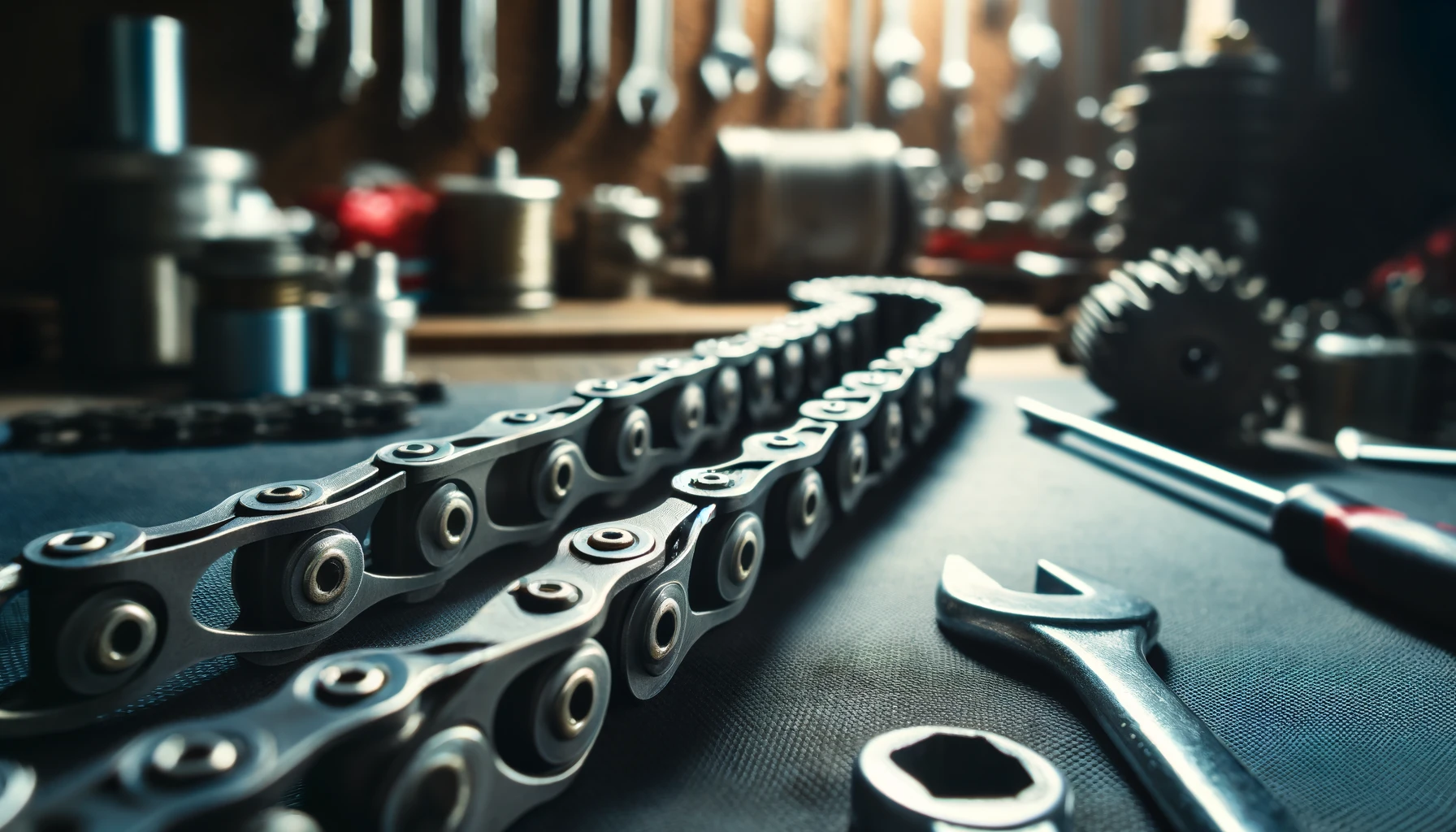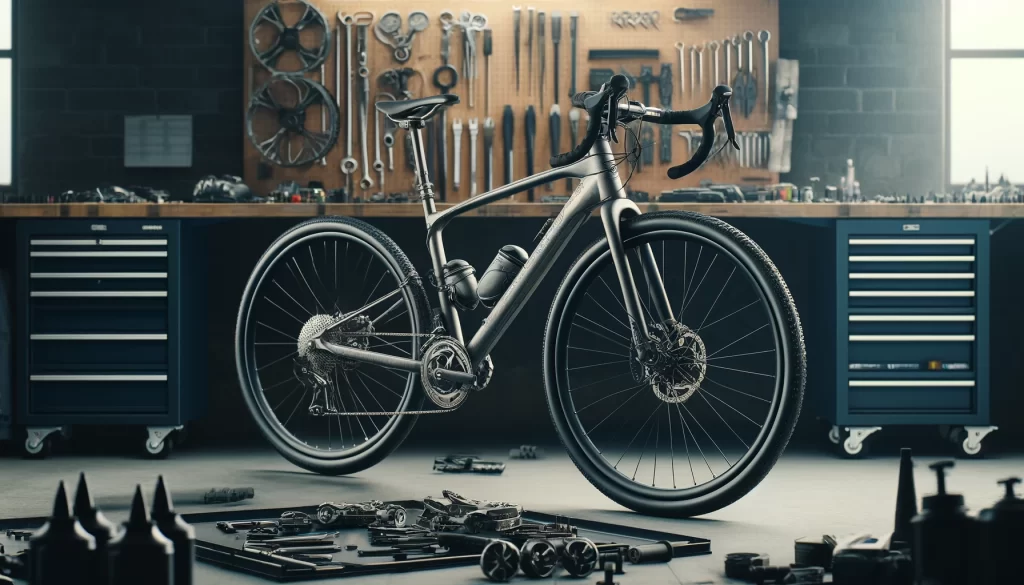Bicycle chain maintenance might not be the most glamorous part of cycling, but it’s absolutely essential for ensuring your bike performs well on every ride.
This unassuming component is fundamental in transferring the power from your pedal strokes to your wheels, and neglecting it can lead to inefficient riding and increased wear on your bike. This guide is crafted to help you master the art of bicycle chain care, covering everything from routine checks to deep cleaning techniques.
As we delve into the best practices for maintaining your bicycle chain, you’ll discover not only how to keep it in top condition but also how to extend its lifespan, saving you money and hassle in the long run. Whether you’re tackling steep hills, racing on flat terrains, or just enjoying a leisurely ride around the park, a well-maintained chain is key to a smooth experience.
Stay with us as we unlock the secrets to keeping your bike’s heartbeat strong and dependable.

Image Source: Image Generated With DALL-E on ChatGPT
Necessary Tools for Chain Maintenance
For effective bicycle chain maintenance, having the right tools is essential. You’ll need a chain cleaner or brush, a quality degreaser, chain lubricant, and a rag for wiping off excess oil. Optionally, a chain checker tool can be very useful to measure chain wear and determine when a replacement is needed. These tools help ensure that the chain runs smoothly, extends its lifespan, and maintains your bike’s performance.
Tips for Choosing Chain Maintenance Tools:
- Select a Quality Degreaser: Opt for a degreaser specifically designed for bike chains to effectively remove grime.
- Use a Dedicated Chain Brush: These brushes are shaped to fit the chain’s contours, making cleaning more thorough.
- Invest in a Chain Checker: Regularly check your chain for wear to replace it before it affects other drivetrain components.
Step-by-Step Guide to Cleaning Your Bicycle Chain
Cleaning your bicycle chain regularly is crucial for maintaining smooth riding conditions and prolonging the life of your bike’s drivetrain. Here’s how to effectively clean your bicycle chain.
Step-by-Step Guide for Cleaning a Bicycle Chain:
- Position Your Bike: Secure your bike in a stand or flip it over so you can easily access the chain.
- Apply Degreaser: Liberally apply a chain-specific degreaser to the entire chain. Let it sit for a few minutes.
- Scrub the Chain: Use a chain brush or an old toothbrush to scrub the chain, removing built-up dirt and grease.
- Rinse the Chain: Wash off the degreaser with water. Be thorough to avoid leaving any residue.
- Dry the Chain: Thoroughly dry the chain using a clean rag to prevent rust.
- Lubricate the Chain: Apply a suitable lubricant evenly along the entire length of the chain while spinning the pedals.
- Wipe Off Excess Lubricant: Use a rag to wipe away excess lubricant to prevent attracting dirt.
Effective Homemade Techniques for Cleaning Your Chain
Cleaning your bicycle chain doesn’t always require specialized products; you can use some homemade solutions effectively. A mixture of dish soap and warm water can work well to cut through grease and grime. For a deeper clean, baking soda mixed with water creates a powerful paste that can break down tough residue. Using these simple household items can be both cost-effective and environmentally friendly.
Tips for Homemade Chain Cleaning
- Use Dish Soap Solution: Mix dish soap with warm water and apply it to the chain for a basic clean.
- Try Baking Soda Paste: Combine baking soda with a little water to make a paste for scrubbing hard-to-remove grime.
- Rinse Thoroughly: Always rinse the chain thoroughly with clean water after cleaning to remove any soap residue.
How to Choose the Ideal Lubricant for Your Chain
Selecting the right lubricant for your bicycle chain is crucial for ensuring optimal performance and durability. Lubricants come in different forms: wet, dry, and wax. Wet lubricants are best for moist conditions as they are more water-resistant. Dry lubricants are ideal for dry conditions as they attract less dirt. Wax lubricants provide long-lasting protection but require more frequent application.
Guide to Choosing the Right Chain Lubricant
- Consider the Riding Conditions: Choose wet lubricants for wet conditions and dry lubricants for dry, dusty conditions.
- Assess Lubricant Type: Wet, dry, or wax, each type has its specific application and benefits.
- Check for Compatibility: Ensure the lubricant is compatible with your bike’s chain material and type.
Best Practices to Prolong the Life of Your Bike Chain
Maintaining your bike chain properly is crucial to prolonging its lifespan and ensuring your bike operates smoothly. One of the key practices is regular cleaning and lubrication, which prevents the buildup of dirt and grime that can accelerate wear and tear.
It’s also important to adjust your riding style; avoiding shifting gears under high pedal pressure can reduce the strain on the chain and minimize the risk of stretching or breaking it. Using your gears wisely by shifting before the terrain changes can help maintain the chain’s integrity over time.
Another best practice is to regularly check the chain for wear using a chain checker tool or a ruler. A chain stretched beyond 0.5% of its original length is typically due for replacement to prevent excessive wear on other drivetrain components.
Additionally, ensuring that your chain is properly aligned and tensioned can avoid uneven wear and tear. Keeping the cassette and chainrings clean and replacing them before they are excessively worn will also protect your chain, keeping the entire drivetrain functioning efficiently and extending the life of all parts involved.

Image Source: Image Generated With DALL-E on ChatGPT
Ideal Maintenance Frequency for Different Cycling Uses
The frequency of bicycle maintenance can vary significantly depending on how you use your bike. For regular commuters or daily riders, a weekly check of the chain’s condition and cleanliness is recommended.
This includes a quick wipe down of the chain and a monthly deep clean and lubrication to address the constant exposure to urban pollutants and variable weather conditions. For mountain bikers, who often face mud, dust, and debris, a thorough cleaning and lubrication after every ride is ideal to prevent the abrasive particles from causing wear.
For casual riders who may not use their bikes as frequently, a more flexible maintenance schedule can be adequate. Such riders should perform a comprehensive check every few months or after extended periods of storage.
Regardless of the type of cycling, a pre-ride check to ensure the chain is lubricated and free of debris can greatly reduce the risk of mechanical issues during the ride. Moreover, the end of each season is a good time for a detailed inspection and maintenance to prepare the bike for the next season or for storage, ensuring that all components are in optimal condition.
Common Questions About Essential Bicycle Chain Care
1. How often should I clean and lubricate my bike chain? The frequency depends on your riding conditions and frequency. Regular commuters should aim for a weekly wipe and a monthly deep clean and lubrication. Mountain bikers should clean after each ride due to exposure to harsher conditions.
2. What type of lubricant should I use for my bike chain? Select a lubricant based on your typical riding environment: wet lubricants for damp conditions, dry lubricants for dry or dusty conditions, and wax lubricants for a clean application with lasting protection.
3. How do I know if my bike chain needs to be replaced? Use a chain checker tool or measure with a ruler. If the chain has stretched 0.5% beyond its original length, it’s time to replace it to avoid damaging other drivetrain components.
4. Can I use household oils or WD-40 to lubricate my chain? It’s best to use lubricants specifically designed for bike chains. Household oils might not provide the necessary protection against wear and environmental conditions, and WD-40 can actually strip away the lubrication needed for effective chain function.
5. Is it necessary to remove the chain from the bike for cleaning? While not always necessary, removing the chain can allow for a more thorough cleaning. If your chain has a quick link, removal and reinstallation can be done relatively easily.
Taking care of your bicycle chain is not just about maintaining the bike’s performance but also about extending the life of its parts. Regular cleaning, proper lubrication, and timely replacement are crucial steps in avoiding unnecessary wear and ensuring that each ride is smooth and efficient.
Remember, your bike’s chain is as important as the engine in a car—it powers your ride, and its care should never be overlooked. By adhering to the guidelines outlined in this essential care guide, cyclists can enjoy a reliable and satisfying cycling experience, keeping both the bike and its rider in great shape for years to come.
Did you like the article? Be sure to check out more content like this in the Maintenance Guide category or see more related content below.






